Learn how to make Kombu Dashi, a vegan-friendly Japanese soup stock, at home and enhance your Japanese dishes with umami flavor!
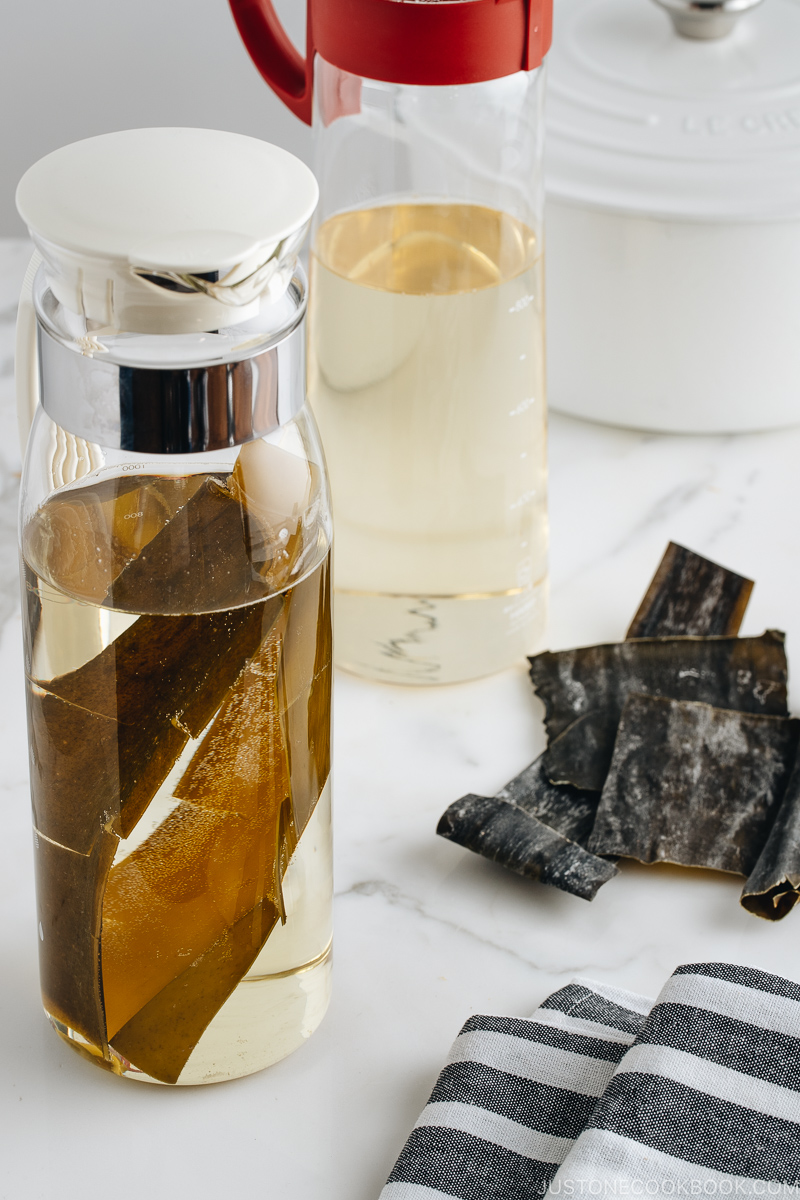
Dashi (Japanese soup stock) is a Japanese soup stock, and it is a fundamental ingredient in many Japanese dishes to create authentic flavor. Today I want to share how to make Kombu Dashi (昆布だし).
What is Kombu Dashi?
Kombu Dashi (昆布だし) is a Japanese soup stock made with kombu (昆布 dried kelp), dried kelp that is used extensively in Japanese, Korean, and Chinese cooking. In Korean, it is referred to as dasima (다시마), and in Chinese as haidai (海带).
Kombu Dashi is vegetarian and vegan and the easiest dashi you can make.
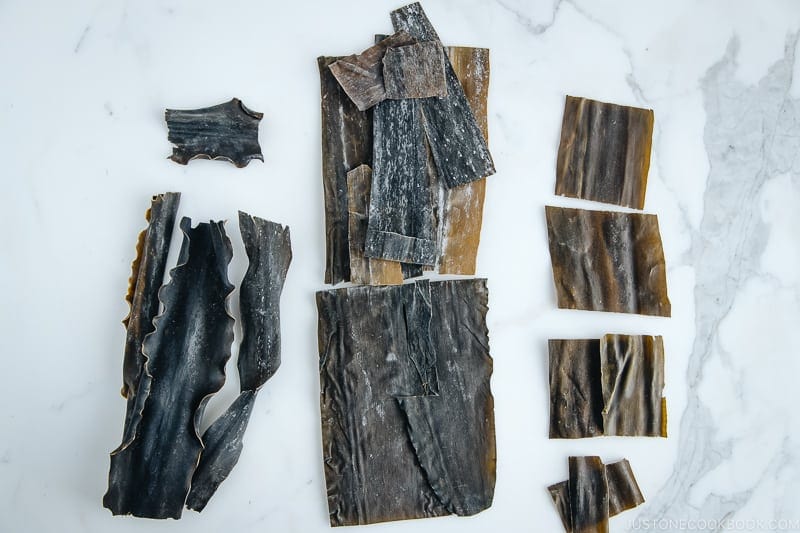
This sea vegetable earns its name as ‘the king of seaweeds’ because it possesses an amazing flavor and nutritional value, unlike any other seaweed. The most noteworthy advantage is its high content of glutamic acid, an amino acid responsible for umami. And umami is what you’re looking for in a dish where it provides a complex, elemental taste.
If you follow a vegetarian/vegan diet or simply want to embrace a more plant-based diet, kombu is an outstanding ingredient to incorporate into your cooking. Besides being a great flavor enhancer and tenderizer, kombu is a powerful, health-promoting food that can make up for certain nutrients that are absent in the diets.
In my pantry kombu page, I discuss different types of kombu and which kombu is good for specific types of food. Please go over the post if you want to know more about how to use kombu for Japanese cooking.
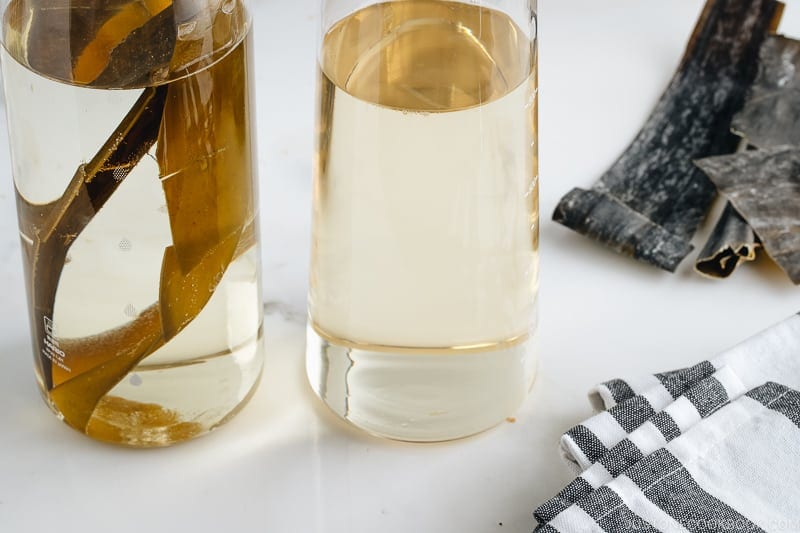
Two Methods in Making Kombu Dashi:
Method 1: Cold Brew
The cold brew or Mizudashi (水出し) method is pretty hands-off. All you need is to put water and 1-2 kombu strips in a large bottle, let steep for 2-3 hours or more.
Method 2: Hot Brew
If you need dashi right away, the hot brew or Nidashi (煮出し) is the method you can go with. Just place the kombu and water in a medium pot and gently bring out the flavor. Turn off the heat before it comes to a boiling point.
A few quick tips on cooking with kombu:
- There is no need to wash or wipe off the white powdery substance as kombu is pretty clean these days. The white compound is known as Mannitol which is the key contributor to the umami.
- Make a couple of slits on the kombu will help release more flavor.
- Do not throw away the leftover kombu as it is can be repurposed into Kombu Tsukudani (Simmered Kombu) or Homemade Furikake (rice seasoning).
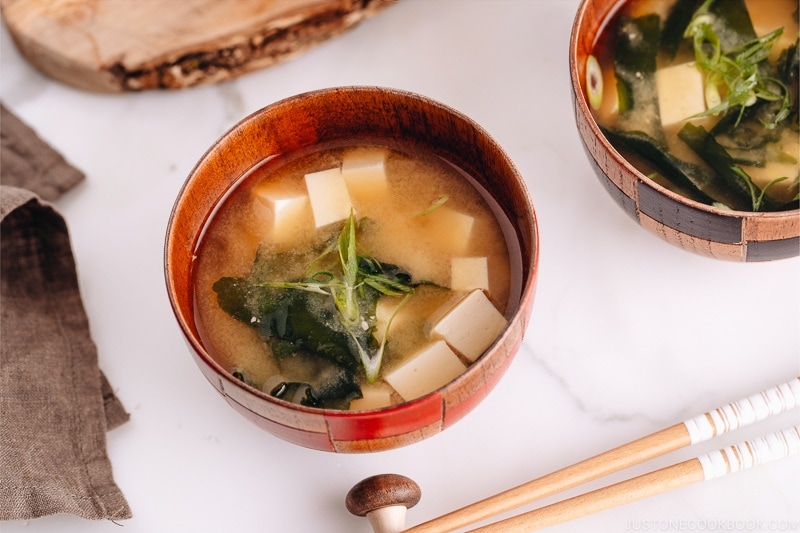
Recipes Using Kombu Dashi
If you can’t access kombu, another delicious option for making another vegetarian/vegan dashi is Shiitake Dashi.
The Ultimate Dashi Guide
Dashi plays an important role as a flavor enhancer in Japanese cooking, so you don’t need to season the food with too much salt, fat, and sugar. Rich in minerals and other vitamins, dashi is considered a healthy ingredient in our daily diet.
There are six different types of dashi you can use in Japanese cooking, including vegetarian and vegan dashi (*).
- Awase Dashi – a stock made from a combination of dried kelp + bonito flakes
- Kombu Dashi * – a stock made from dried kelp
- Katsuo Dashi – a stock made from dried bonito flakes
- Iriko Dashi – a stock made from dried anchovies/sardines
- Shiitake Dashi * – a stock made from dried shiitake mushrooms
- Vegan Dashi * – a stock made from dried shiitake mushrooms and kombu
If you are new to different types of dashi, check out my Ultimate Dashi Guide.
Wish to learn more about Japanese cooking? Sign up for our free newsletter to receive cooking tips & recipe updates! And stay in touch with me on Facebook, Pinterest, YouTube, and Instagram.
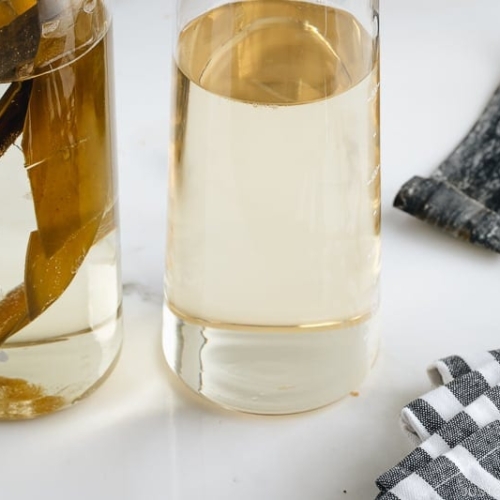
Kombu Dashi (Vegan Dashi)
Video
Ingredients
- 1 piece kombu (dried kelp) (10 g; 4 x 4 inches, 10 x 10 cm per piece)
- 4 cups water
Instructions
- Gather all the ingredients. Most Japanese recipes say to gently clean the kombu with a damp cloth. However, these days, kombu is pretty clean so just make sure it doesn‘t have any mold spots and it‘s ready to use. Do not wash or wipe off the white powdery substance as it has lots of umami.

- Make a couple of slits on 1 piece kombu (dried kelp) to release more flavor.

Method 1: Cold Brew Kombu Dashi (Mizudashi)
- Put 4 cups water and the kombu in a large bottle.

- Put the cap on and let it steep on the counter for 2–3 hours in the summertime and 4–5 hours in the wintertime. You can also cold brew the Kombu Dashi overnight in the refrigerator.

- Remove the kombu from the bottle and reserve the spent kombu (see below). The Kombu Dashi is now ready to use. If you are not using the dashi right away, save it in a bottle and keep in the refrigerator for 4–5 days or in the freezer for 2 weeks. I recommend using it sooner for the best flavor.

Method 2: Kombu Dashi on the Stovetop (Nidashi)
- Put the kombu and water in a medium pot. If you have time, soak for 3 hours or up to a half day. The kombu’s flavor comes out naturally from soaking in water.

- Turn on the heat to medium low and slowly bring to a bare simmer, about 10 minutes.

- Meanwhile, clean the dashi by skimming the foam from the surface with a fine-mesh skimmer.

- Just before the dashi starts boiling, remove the kombu from the pot (see below for what to do with it). If you leave the kombu in the pot, the dashi will become slimy and bitter.

- Now the Kombu Dashi is ready to use.

To Store
- If you are not using the dashi right away, keep it in a bottle or airtight container and store in the refrigerator for 4–5 days or in the freezer for 2 weeks. I recommend using it sooner for the best flavor.
What to do with the spent kombu?
- Save the spent kombu in an airtight container and store it in the refrigerator for a week or in the freezer for up to a month.

- With the spent kombu, you can make Simmered Kombu (Kombu Tsukudani).

- You can also make Homemade Furikake (Rice Seasoning).

Nutrition
Editor’s Note: This post was originally published in February 2013. The images have been updated in April 2019.
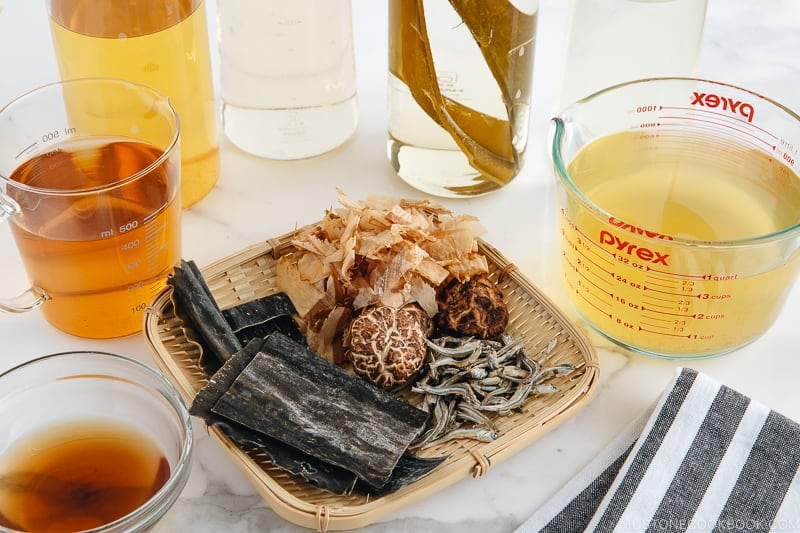
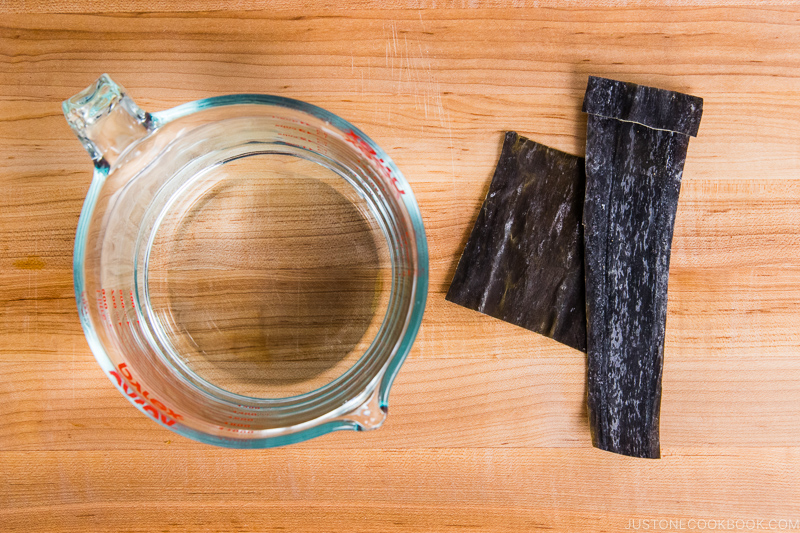
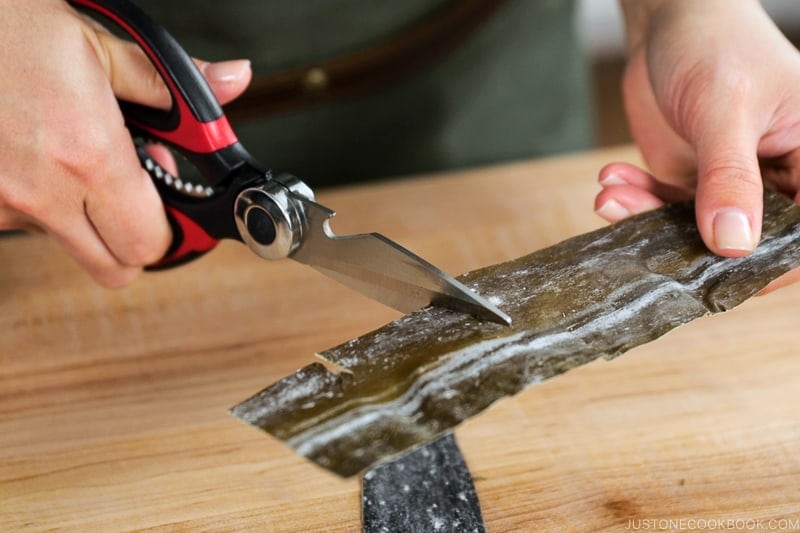
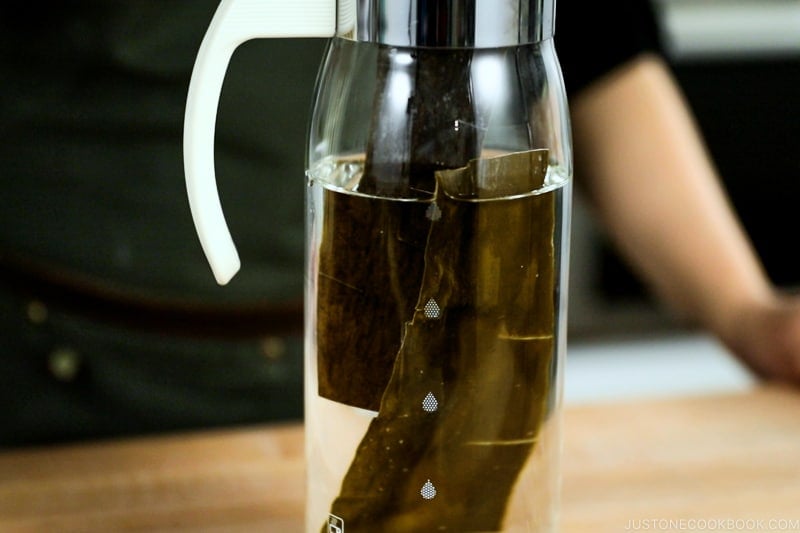
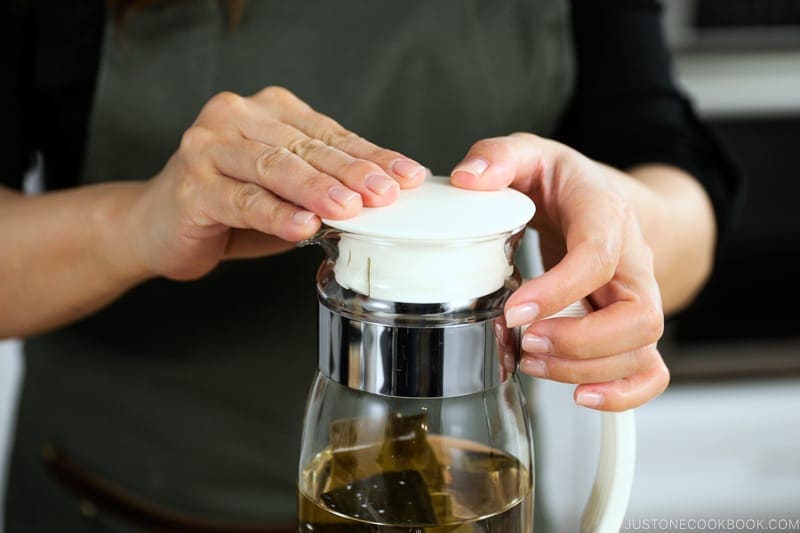
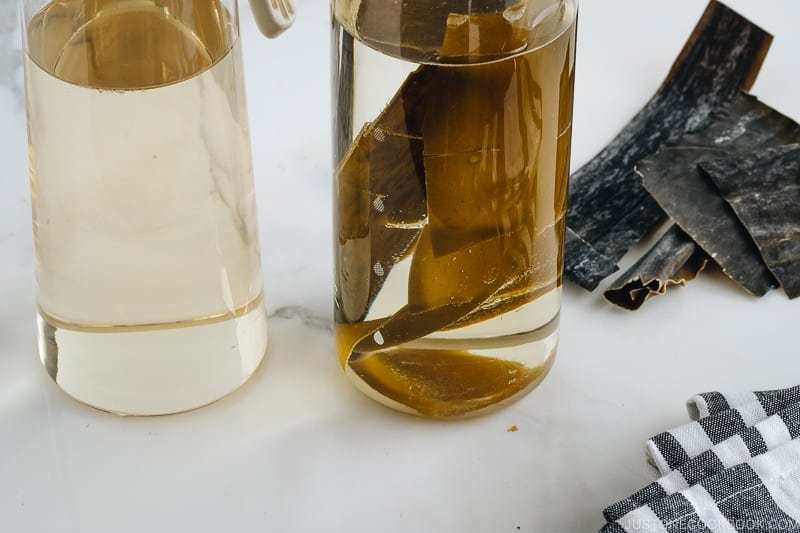
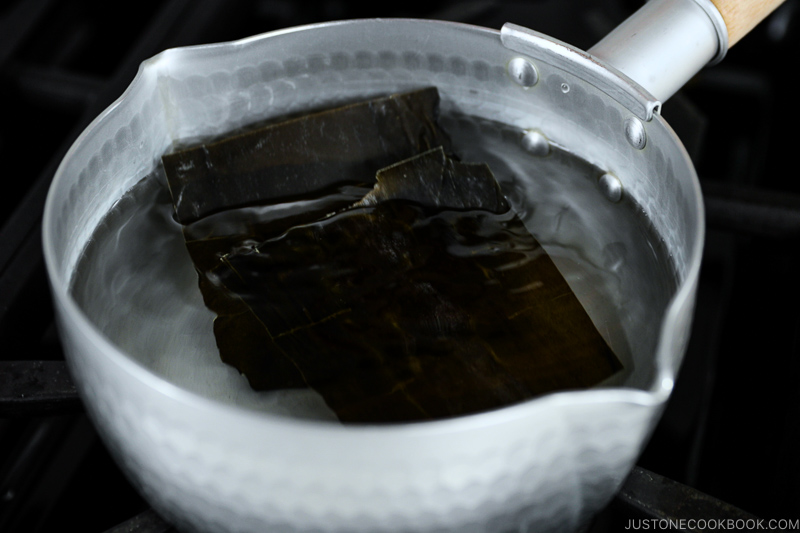
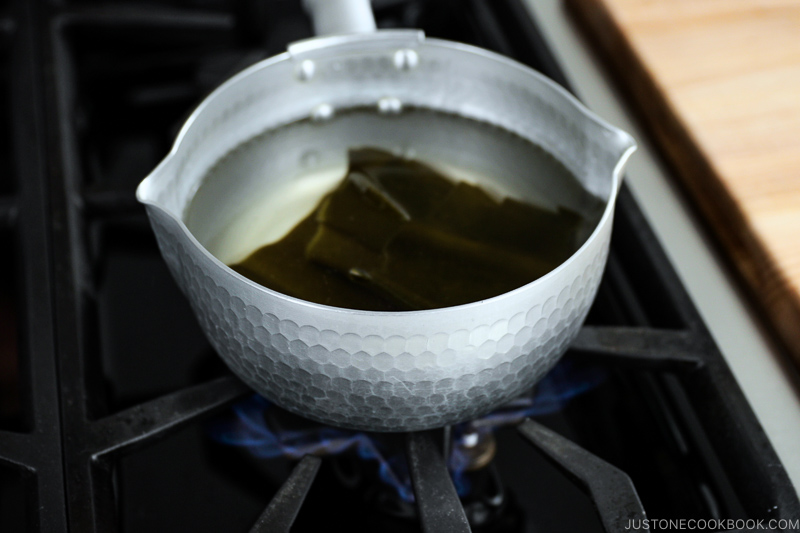
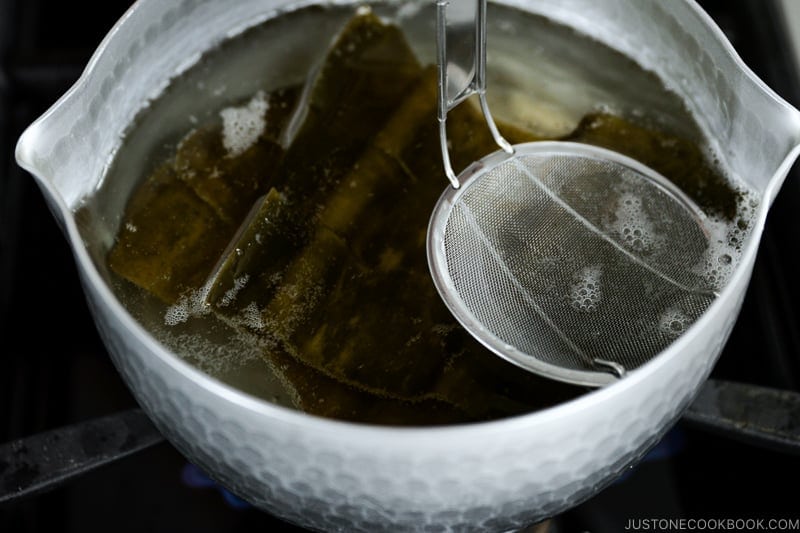
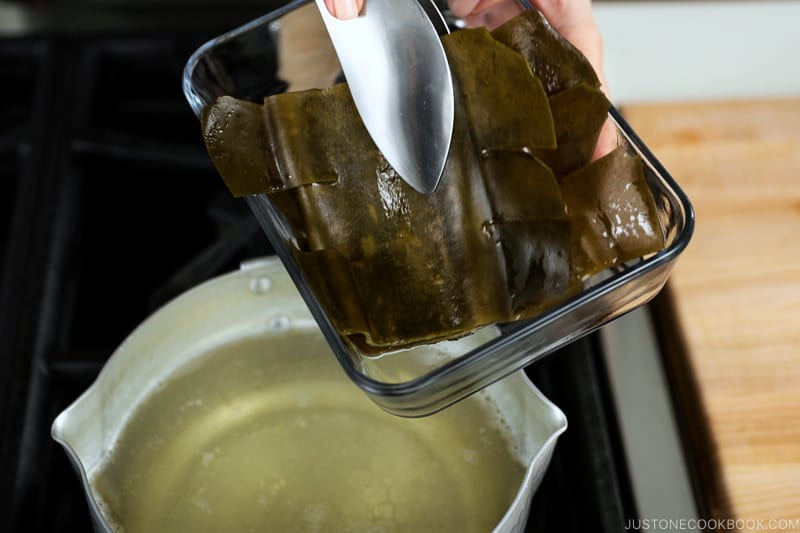
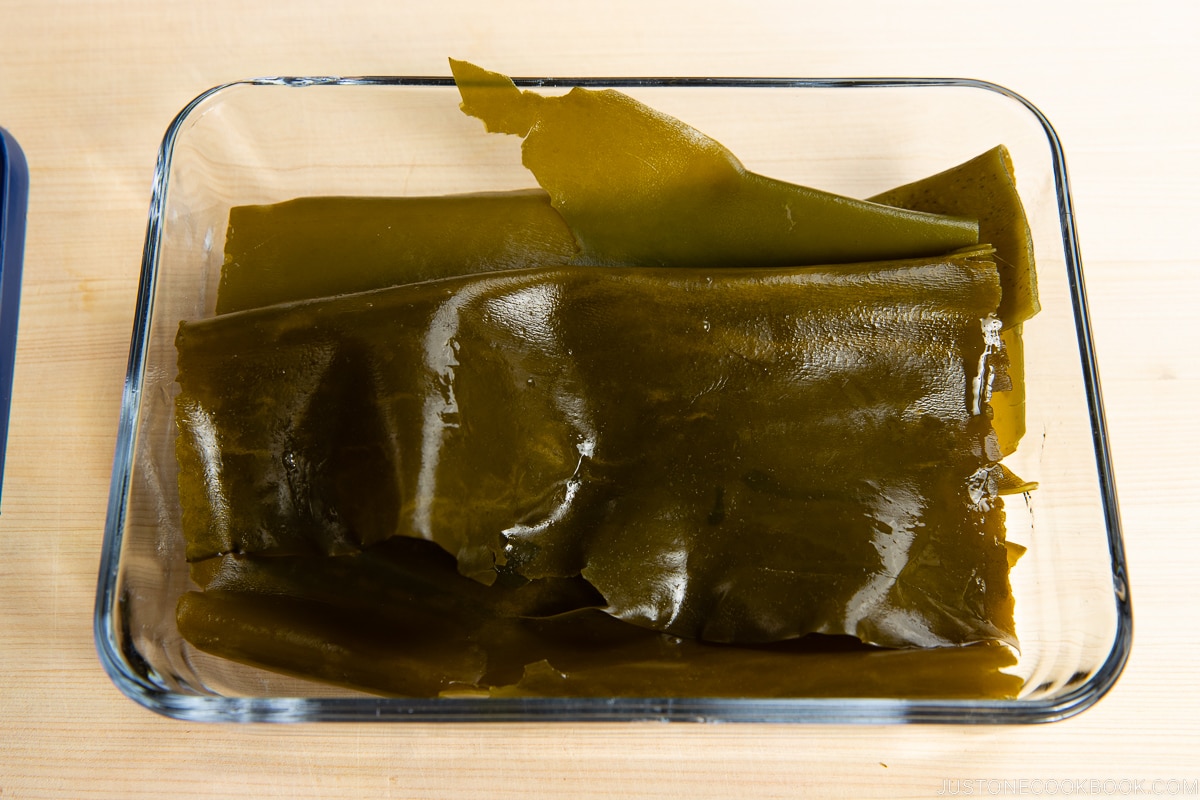
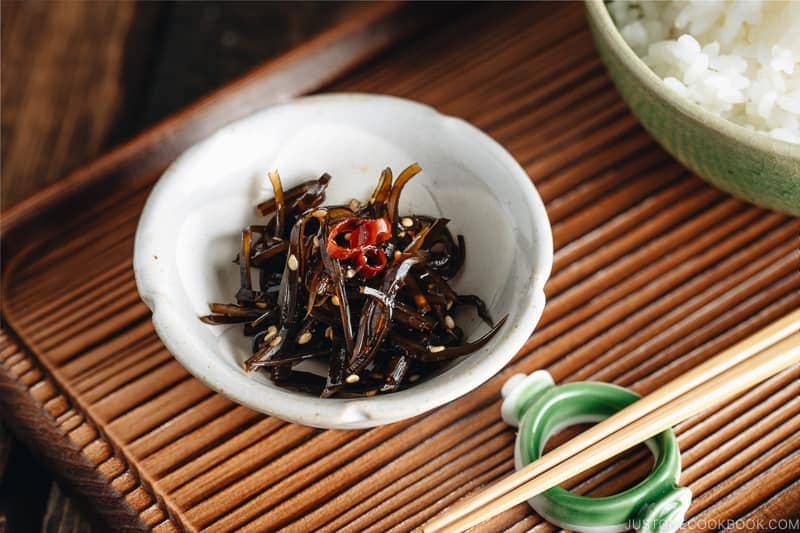
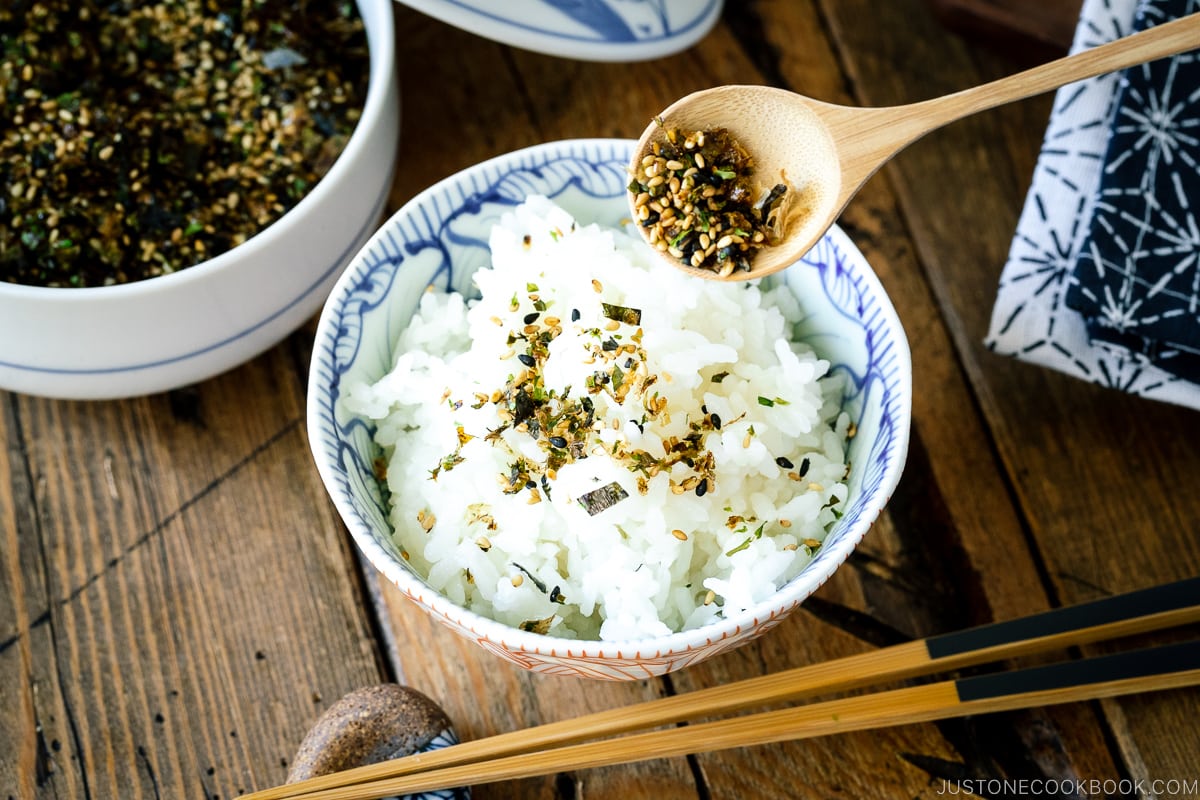

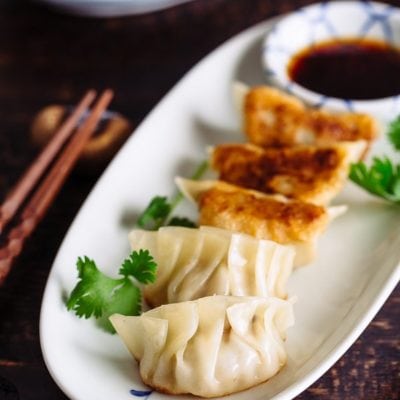
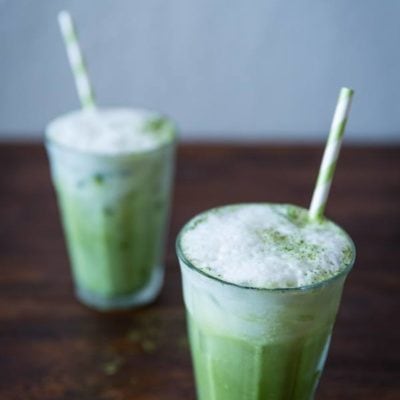





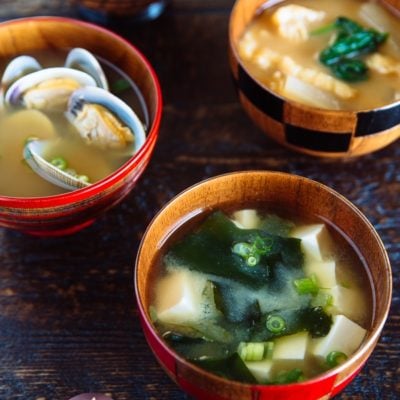

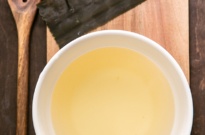
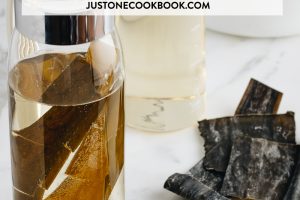
I love your style of cooking, it’s clear and to the point. Good luck.
Malcolm
Hi Malcolm! Thank you so much for your kind words. I’m happy to hear my recipes are useful. 🙂
Hi Nami,
I’m so excited to have found
D your page. Everything looks delicious. I have a question, I started to make the vegetarian dashi yesterday for the vegetarian ramen with soy milk and something came up. So I left the dried mushrooms and the Kombi soaking in the water overnight. Do I need to still put it on the stove to cook or can I just strain it and use it as is? Looking forward to your reply.
Sincerely,
Esther
Hi Esther! Welcome to my blog! Hope you find some dishes you enjoy on my blog. I apologize for my late response (I get a lot of comments, so if you’re in hurry, please tweet me). You keep the kombu and shiitake until the dashi is ALMOST boiling. Then you discard the kombu and shiitake. You can get the umami out of kombu and shiitake while you slowly heat up. Hope that helps!
It is so nice to see a version of Dashi stock that is easy to make and easily accessible to someone who cannot actively obtain bonito flakes.
I do however have a question: Can Kombu Dashi be used as a substitute for all of the recipes that require some form of Dashi stock?
Hi Julieanne! Yes, you can use kombu dashi for everything. If you want additional flavor, you can combine shiitake dashi (https://www.justonecookbook.com/shiitake-dashi/) as well, but remember this one is a bit strong flavor so make sure you add it for the right food/recipe. Most should work with the combination. Also we have anchovy dashi (iriko dashi: https://www.justonecookbook.com/iriko-dashi-anchovy-stock/) as well. It gives stronger flavor – I wouldn’t call fishy but maybe if you’re not used to fish you may disagree with me. 🙂 That is good for miso soup too!
Hi Nami, you don’t know me yet, but since quite a while you’re sort of my personal trainer for Japanese kitchen (I’m German and not too familiar with Japanese food).
A few days before I cooked your Kombu Dashi – exactly as you outline it. The taste was fine (although I prefer the Awase Dashi), but the Kombu made the water extremely slimy after soaking for 3 hours – still before I heated it up. The weird consistency might be something I will get used to sooner or later, I just want to ask you whether this behaviour is normal or if there’s a way to get the Kombu Dashi less slimy. There seems to be connection to the amount of Kombu. When I use less of it (in Awase Dashi), the water doesn’t get slimy at all.
Hi Ralf! It can get slimy IF you soak the kombu for a long time. I’ve changed my own directions and changed from 10 hours to 2-3 hours (summer) or 4-5 hours (winter). I know you tried for 3 hours and still has sliminess but should not be slimy in the dashi. Kombu should be slimy though. Was it kept in the fridge? We avoid and minimize this sliminess. Maybe try for shorter time? Some recipes in Japan say 10 hours some says a few hours… both are legitimate methods too, so it might be depends…. Maybe keep the amount of kombu but less time?
what do you do with the discarded kombu? do you have to throw it away? thanks 🙂
Hi Roby! You can make furikake, rice seasoning.
https://www.justonecookbook.com/how_to/homemade-furikake-rice-seasonings/
Hello I am from India ,have just started cooking Japanese food ,sometimes we do not get all the ingredients easily,instead of kombu we get powdered Kombu dashi powder ,how does one use that to make the dashi thanks
Hi Nivedita! I’m so happy to hear you started to cook Japanese food! For dashi powder, you can follow this direction:
https://www.justonecookbook.com/how-to-make-dashi-3-ways/
Thank you for this. I actually forgot to buy either dried shitake or bonito flakes so i had to do this for a party.
Hi Martin! Hope kombu dashi worked for your dish! 🙂
Can I reuse the Kombu to make more dashi?
Usually Nibandashi (2nd time making dashi) is with Katsuobushi, not with kombu. You can reuse kombu to make “Tsukudani” – braised kombu with soy sauce, sugar, mirin, sake…. if you have katsuobushi for dashi you can make furikake (rice seasonings) too. 🙂
https://www.justonecookbook.com/how_to/homemade-furikake-rice-seasonings/
Why tell us you are not interested? Who cares?
what do you mean…..
Hi,
can I eat the kombu after using it for the dashi? Are there other uses for it?
thanks 🙂
Hi Federica! It has not much flavors left but we still enjoy the texture of the kombu.
https://www.justonecookbook.com/how_to/homemade-furikake-rice-seasonings/
Just one of leftover kombu use. 🙂
Have just discovered your website and I love it!! Thank you so much. Two questions with the Kombu, is there a preferred method (mizudashi vs Nidashi) when making the Kombu dashi for Agedashi Tofu? And also can the soaked Kombu then be used in anything else?
Thanks so much
Hi Nadia! So happy to hear you found my site! Welcome! 🙂
1) I prefer to use Nidashi to get more flavor out of kombu. But I always soak the kombu ahead of time (Mizudashi) before boiling.
2) For Agedashi Tofu, or most of my dishes, I use Awase Dashi with kombu and katsuobushi. Much more flavors and so delicious!
3) Kombu, we usually throw away after extracting the flavors.
Thank you!
Thank you for that, just to confirm (I am making it now!!) after soaking the kombu overnight, do you then boil it in the water you had it soaking in? Or discard it and boil it in fresh water?
Thanks again!
Yes pour same water into the pot to get more flavor out of the Kombu. Make sure to take it out just before boiling. 🙂
Thanks so much! I really appreciate it! I will save this recipe! By the way, do you know a recipe for vegan fermented black beans? I have been trying unsucessfully to find a recipe for homemade vegan fermented beans for some time and if you do have one, I could really use it. Thanks again!
Hi Marilyn! I’m not sure how to make it – I think it’s the Chinese condiment right? Sorry I wish I know how…
Hi – what is the difference between the cold and hot method? Is the hot one richer in umami?
Hi Charlotte! For kombu dashi, it’s always recommended to soak in cold water for a longer time (such as overnight) first before cooking the kombu. Only when you don’t have time, you can SLOWLY heat up so that umami will come out from kombu. Never drop kombu in hot water, for example. Hope this helps? 🙂
Nami! Thank you for sharing! By the way I’ve heard shiitake dashi gives weak taste to miso soup as if it is used as the only dashi in the soup. Is kombu dashi has the same level of taste as shiitake dashi? I would try another shot with this kombu if it taste as great as those non-vegetarian dashi 😀
Hi Audrey! Yes, it’s not strong enough for miso soup especially miso you use is strong one like red miso. The smell can be strong if you don’t like shiitake. Kombu is very mild too compared to katsuo (bonito) dashi. But you can definitely taste the umami if you compare miso soup with water vs. miso soup with kombu dashi.
Thank you for replying 😀 Well it’s hard to find various options for miso in my city (there was only white miso at the moment), I decided to give furusato miso a try as I hoped it might taste something like mild and a bit sweet but found out salty :”) I love shiitake fortunately. Will it make any significant difference if next time I combined kombu and shiitake dashi? Which dashi should have more proportion? What do you think? I’m sorry if I ask too much question hehehe
Hi Audrey! Not at all, please feel free to ask me anytime. 🙂 For miso soup, unless it’s “clear soup”, we don’t usually use shiitake dashi. So I’d use just kombu for vegetarian option. Now for miso, white miso is the most mild and it’s a good choice. You can control the amount of miso you add to the kombu dashi. Start with little amount. Each brand of miso has different salt amount, so you have to decide what’s the right taste for you (and make sure to dissolve all the miso before you add next portion). Hope this helps! 🙂
Oh Nami thank you very much for your suggestions, helps me so much! I am sure now to use kombu dashi next time (read: as soon as I have eaten up this batch of miso soup hahaha). Thanks to you I’ve just known that the saltiness of miso is different each brand, I thought it was all the same. Thank you once again, Nami you’re very kind 😀
You’re welcome, Audrey Happy to help! 🙂